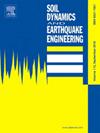地震作用下隧道-边坡体系动力损伤演化机理的振动台试验
IF 4.2
2区 工程技术
Q1 ENGINEERING, GEOLOGICAL
引用次数: 0
摘要
强震区隧道穿越边坡的地震耦合灾害效应,以及隧道-边坡系统的动态破坏演化机理,仍然是地下工程抗震领域的关键科学难题。本研究通过振动台模型试验来模拟隧道洞门部分在地震荷载作用下的动态响应行为。通过利用希尔伯特-黄变换(HHT)和边际谱(MS)的综合分析方法,阐明了地震能量在隧道-斜坡系统中的传递机制。结果表明,隧道的地震变形呈现拉伸-压缩交替循环模式。在近边坡区域,隆起型破坏占主导地位,而在远边坡区域,破坏模式的特点是压缩变形从隧道上部和下部向隧道中心发展。随着地震烈度的增加,隧道的峰值频率逐渐降低(从 16.18 Hz 降至 14.85 Hz)。MS 振幅主要集中在 10-30 Hz 频段,隧道反面和侧壁等较低区域表现出明显的破坏敏感性。随着系统损伤的发展,隧道与边坡之间的动态关系发生了持续演变,滑动面的形成和变形成为边坡失稳的充分条件。隧道-边坡系统的破坏演化过程可分为四个特征阶段:初始微变形阶段→塑性破坏孕育阶段→剪切滑移发展阶段→坍塌和滑动破坏阶段。研究成果为强震区隧道工程抗震设计和边坡稳定性评估提供了重要指导。本文章由计算机程序翻译,如有差异,请以英文原文为准。
Shaking table tests on dynamic damage evolution mechanism of tunnel-slope system by seismic motions
The seismic coupling disaster effects of tunnels traversing slopes in strong earthquake zones, along with the dynamic damage evolution mechanism of the tunnel-slope system, remain key scientific challenges in the field of seismic resilience for underground engineering. In this study, a shaking table model test was conducted to simulate the dynamic response behavior of the tunnel portal section under seismic loading. Through a combined analytical approach utilizing the Hilbert-Huang Transform (HHT) and the Marginal Spectrum (MS), the mechanisms governing seismic energy transfer in the tunnel-slope system were clarified. The results indicate that the seismic deformation of the tunnel exhibits an alternating tensile-compressive cyclic pattern. In the near-slope region, uplift-type failure dominates, whereas in the far-slope region, the failure mode is characterized by compressive deformation progressing from the upper and lower sections of the tunnel toward its center. As the seismic intensity increases, the peak frequency of the tunnel exhibits a gradual decrease (from 16.18 Hz to 14.85 Hz). The MS amplitude is predominantly concentrated in the 10–30 Hz frequency band, with the lower regions, such as the tunnel invert and sidewalls, demonstrating significant damage sensitivity. As system damage progresses, the dynamic relationship between the tunnel and the slope undergoes continuous evolution, and the formation and transfixion of the sliding surface serve as a sufficient condition for slope instability. The damage evolution process of the tunnel-slope system can be categorized into four characteristic stages: initial micro-deformation stage → plastic damage incubation stage → shear slip development stage → collapse and sliding failure stage. The research findings provide significant guidance for the seismic design of tunnel engineering in strong earthquake zones and the assessment of slope stability.
求助全文
通过发布文献求助,成功后即可免费获取论文全文。
去求助
来源期刊

Soil Dynamics and Earthquake Engineering
工程技术-地球科学综合
CiteScore
7.50
自引率
15.00%
发文量
446
审稿时长
8 months
期刊介绍:
The journal aims to encourage and enhance the role of mechanics and other disciplines as they relate to earthquake engineering by providing opportunities for the publication of the work of applied mathematicians, engineers and other applied scientists involved in solving problems closely related to the field of earthquake engineering and geotechnical earthquake engineering.
Emphasis is placed on new concepts and techniques, but case histories will also be published if they enhance the presentation and understanding of new technical concepts.
 求助内容:
求助内容: 应助结果提醒方式:
应助结果提醒方式:


